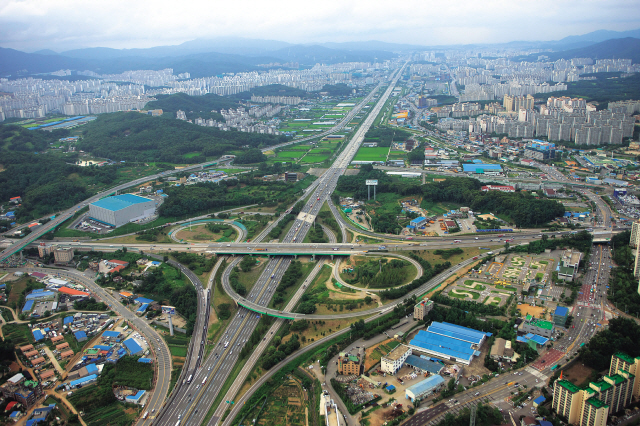[Power Korea] Roads ― the arteries of development
From expressways to city streets, road infrastructure also contributes to balanced regional development and improved living standards
By Korea HeraldPublished : May 20, 2013 - 20:53
The Korea Herald is publishing a series of articles on infrastructure as part of its second installment of Power Korea. Korea’s success story is a 60-year-old tale written by not one, but many who worked to build one of the world’s most powerful nations from the ashes of war. This series features the development and global competitiveness of Korea’s infrastructure. The special articles were made in cooperation with the Ministry of Land, Infrastructure and Transport. This is the second part of the infrastructure series. ― Ed.
The nation’s road infrastructure played a critical role in the rapid recovery from the Korean War and economic growth.
Under the law, the nation’s roads are classified into seven categories: national expressways, national highways, metropolitan roads, city roads, provincial roads, county roads and district roads. The nation’s road network is mainly made up of expressways and highways, which are linked to major urban areas and small cities.
Road construction was a starting point for the nation’s economic revival in the 1960s. It also contributed to balanced regional development and improved living standards.
The nation’s road infrastructure played a critical role in the rapid recovery from the Korean War and economic growth.
Under the law, the nation’s roads are classified into seven categories: national expressways, national highways, metropolitan roads, city roads, provincial roads, county roads and district roads. The nation’s road network is mainly made up of expressways and highways, which are linked to major urban areas and small cities.
Road construction was a starting point for the nation’s economic revival in the 1960s. It also contributed to balanced regional development and improved living standards.

The opening in 1970 of the 416-km Gyeongbu expressway, which links Seoul and Busan, is considered the most important infrastructure achievement in the country’s modern history.
In the 1980s, the hosting of the 1986 Asian Games and 1988 Summer Olympics rapidly increased vehicle registrations and, consequently, traffic congestion. However, investment in large-scale road construction projects slowed during this period. Only two express lines ― the 88 Olympic Expressway (182.9 km) and the Jungbu Expressway (117.8 km) ― were built. The renaissance of expressway construction was in the 1990s. Nineteen expressways, totaling 1,853 km in length, were built with the introduction of a systematic road network plan and new laws for securing financial resources.
City roads and urban transport policy
As in most other developed countries, most Koreans today live in cities. Korea has invested in making its roads more efficient by combining routes with transport systems based on information technology. Seoul City’s road policy and public transport system, in particular, buses, have become benchmarks for many cities in developing countries.
City roads have been expanded along with urban development and rising demand for cars. However, urban road expansion in the 1990s became more difficult because of the rapid rise in the cost of land and relocation issues. Increasing the efficiency of existing infrastructure and interest in public transport were more important than the construction of new facilities. As a result, transport system management and transport demand management policies were proposed as major components of urban transport policy. Transport system management deals with improving the efficiency of existing roads by changing road design and operation techniques.
Reform of the bus network
The reform of Seoul City’s bus network in 2004 is considered a good example of Korean transport system management.
The aim of Seoul’s bus reform was to revitalize the network by improving facilities and services. The reforms introduced a new monitoring system, reorganized bus routes, created exclusive bus lanes, a new bus operating scheme, and a new fare system.
In particular, bus-only lanes were created along the center of major trunk roads. It was a paradigm shift from a car-oriented system to a transit-oriented one in that bus lanes took road space away from cars.
Transport Operation and Information Service was set up in Seoul to manage the operation of buses in real time, using GPS devices installed on every bus.
A smart card system for fare payment was also created, which has since expanded and accommodated the distance-based fare system.
The future of urban transport
Considering the limited space, an urban transport system based on cars is not seen as sustainable. Moreover, the rising price of fossil fuels and climate change due to greenhouse gases are becoming major global issues.
The car-based urban transport system did not survive ongoing urbanization and an increasing population. Now there are calls to alter the public transport-based urban transport system and strictly control the use of private vehicles to make public transport the main mode of travel.
In addition, there are drives to increase the use of eco-friendly modes of transport such as walking and cycling, which improve the quality of life.
When it comes to urban public transport policy, information and technology is rising in importance. Public transport users often have to use various modes of transport to complete their trips, which can be made more convenient by providing real time travel information.
For example, Korea has established a smart card-based integrated ticketing system to improve the efficiency of public transport and users’ convenience. Currently public transport users in Korea can get real-time travel information online.
By Seo Jee-yeon (jyseo@heraldcorp.com)
-
Articles by Korea Herald










![[Hello India] Hyundai Motor vows to boost 'clean mobility' in India](http://res.heraldm.com/phpwas/restmb_idxmake.php?idx=644&simg=/content/image/2024/04/25/20240425050672_0.jpg&u=)









